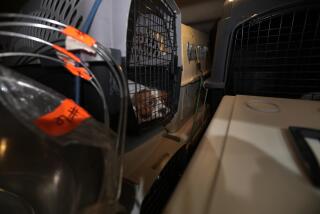Hair of the Dog May Soon Bite Outlaws
- Share via
A killer gets his cat’s fur on his clothing and then sheds it on a victim. A dog licks a burglar as the criminal carries out his booty. A dog urinates on a robber’s car before the getaway.
The tantalizing potential of DNA evidence has long been appreciated by law enforcement and defense attorneys, and they sometimes call on university labs and scientists to analyze evidence.
But experts say animal forensics has lagged as an underutilized novelty -- used sporadically and in a supporting role rather than as the star -- because no available lab is accredited by the American Society of Crime Lab Directors.
Now, investigators at the Orange County district attorney’s office say they have recently made a deal with one of the country’s leading crime labs to analyze animal DNA. The partnership will make the district attorney’s office the first local law enforcement agency in the country to tap animal DNA’s potential.
Animal material will be systematically collected in rape, homicide and other cases. The DNA results will be presented to juries.
“Everybody who has animals knows that you are forever getting their hair on your clothing, so you can imagine how powerful this type of analysis may prove to be,” said Brian Wraxall of the Serological Research Institute in Richmond, Calif., the private lab working with Orange County. The lab is currently accredited for human DNA analysis and plans to become accredited for animal analysis.
Detectives and prosecutors will have to be trained in the new technology. Dog feces, feeding bowls and chew toys may become standard evidence that detectives will take from crime scenes along with spent bullets and fingerprints.
The first use of animal DNA in a criminal case is believed to have occurred in 1996 when Canadian prosecutors used hairs from a cat named Snowball on a bloody jacket to help link a Prince Edward Island man to the murder of his estranged wife.
Animal traits of licking, shedding and urinating have increasingly helped investigators ever since. A hair from Hercules, a pit bull mix in New Mexico, found on a dead woman’s body betrayed his owner as the murderer. Urine sprayed on a truck tire by Rover, an Iowa farm dog, helped identify the man who tried to rape his owner.
The dogs are among the hundreds of animals that have placed criminals at crime scenes.
Many experts, however, say the number of cases solved could reach well into the thousands with an accredited lab such as Serological Research involved.
The labs that have worked for local law enforcement authorities have declined to undergo accreditation, a failure that can leave their findings vulnerable to charges of contamination and mistakes.
“Most labs of any size have quality-control folks, and that’s all they do. We just don’t have the resources for that,” said Beth Wictum, acting director of the forensics division at the Veterinary Genetics Laboratory at UC Davis, the leading evaluator of animal DNA for local criminal cases. The department built its reputation validating the lineage of horses, llamas and other animals. It began criminal forensics in 1999 because of the demand.
But because it lacks accreditation, law enforcement agencies in many jurisdictions decline to use the Davis lab, including Orange County.
“In my opinion you are determining someone’s liberty here,” said Camille A. Hill, the Orange County prosecutor who is spearheading her agency’s animal forensics initiative. “So, I think that animal DNA should be placed under the same scrutiny and standards as human DNA when you are dealing with a case that serious.”
By using Serological Research, Hill’s agency is using the same firm it hired to analyze human DNA in some of Orange County’s highest-profile cases, including Greg Haidl’s rape trial and Alejandro Avila’s trial for the sexual assault and murder of 5-year-old Samantha Runnion.
In the Runnion case, investigators thought that the orange-and-white strands in Samantha’s hair came from Avila’s cat. Hill said her office decided not to send it for DNA analysis because they were worried that forensics work by a lab not accredited for animal forensics would make the prosecution vulnerable to charges of sloppiness.
Ken Goddard, director of the National Fish and Wildlife Forensics Laboratory in Ashland, Ore., said Wraxall’s involvement should put those charges to rest. Goddard’s operation is currently the only crime lab accredited to do animal forensics. Its 22 scientists investigate violations of laws protecting wildlife, including the poaching of endangered species.
“If Brian takes this on, I’m not worried,” Goddard said. “If he gets up and testifies, he’s got it nailed down.”
Scientists wonder whether they will ever be able to say accurately that an animal and an animal hair have a 1-in-1-billion chance of being a genetic match, the ratio often offered in human DNA cases.
The problem with cats and dogs and other animals is that they may be too inbred.
Wictum of the Davis lab said she preferred to state in court that a hair sample and an animal were extremely likely to match. Only when pressed will she offer a more precise figure.
But she is rarely pressed, Wictum said, because the technology still confuses many lawyers.
“I had an attorney ask me whether I could tell whether two dogs were the same species,” Wictum said.
More to Read
Sign up for Essential California
The most important California stories and recommendations in your inbox every morning.
You may occasionally receive promotional content from the Los Angeles Times.











